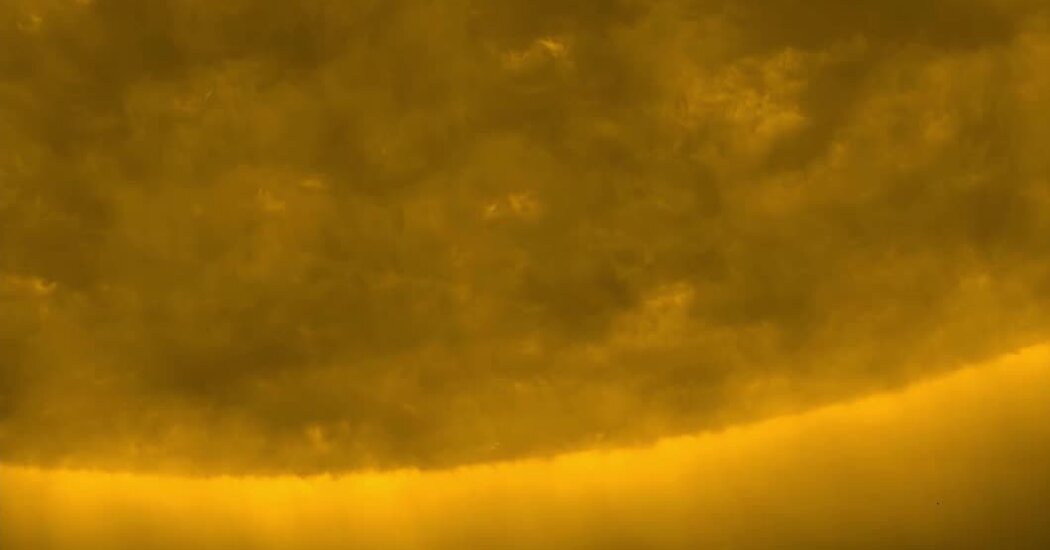Spacecraft and specialized telescopes have been studying the sun closely for decades, probing the secrets of its spots, flares and corona. But neither human nor robotic eyes had properly seen the north or south poles of the sun.
On Wednesday, the European Space Agency released the first clear images of the sun’s south pole, which were captured in late March by its Solar Orbiter spacecraft.
“It’s the first time ever that humanity has had an image of the poles of the sun,” said Carole Mundell, director of science for the European Space Agency. “It’s a wonderful achievement.”
Scientists have had vague glimpses of the sun’s poles before. However, those side-on views have been akin to “looking through grass,” said Mathew Owens, a space physicist at the University of Reading in England, who added that it has been difficult to work out what is happening at the poles and how they differ from other regions of the star.
By studying its polar extremes, scientists hope to gain new insights into the sun and how it behaves.
And the best is yet to come — later this year, humans will get our first images of the sun’s north pole from Solar Orbiter, before the spacecraft swoops ever higher and lower above the sun’s poles for even better views.
The $550 million (€500 million) Solar Orbiter, the size of a car and carrying 10 scientific instruments, launched on Feb. 10, 2020, into an orbit that caused it to fly by Venus repeatedly. These encounters give the spacecraft a gravitational kick, enabling it to push itself out of the plane of orbit that the planets follow around the sun and into a higher angle to view the poles.
Without the help of these planetary slingshots, getting above the sun’s poles is extremely difficult and requires an enormous amount of fuel. Only one spacecraft has flown over the solar poles before, the NASA and ESA Ulysses spacecraft, which operated from 1990 to 2009. But the spacecraft lacked a camera to take any images, carrying only scientific instruments.
Solar Orbiter, conversely, has multiple cameras to capture images of the sun. In March, after four flybys of Venus, the spacecraft swooped about 32 million miles over the sun’s south pole at an angle of about 17 degrees, enough to provide these first-ever snapshots of what it looks like.
“We’ve never had this view before, which is phenomenal,” said Nour Rawafi, a project scientist for NASA’s Parker Solar Probe mission, which is currently flying closer to the sun than any spacecraft in history. “Seeing the poles clearly is really going to open a new window in trying to understand the solar atmosphere and the interior of the sun.”
The images reveal a speckled pattern of magnetic activity at the pole, caused by huge ruptures in the sun’s surface as magnetic fields pour in and out. The sun is currently exiting its period of peak activity called solar maximum, which takes place in an 11-year cycle with solar minimum, and scientists think this might cause the magnetic field inside the sun to flip. That may mean there is no true magnetic north or south pole at the moment, resulting in the speckling effect.
“When the sun is at its minimum, you have a north pole and a south pole, each with its own magnetic polarity,” said Anik De Groof, Solar Orbiter’s mission manager. Now, the magnetic field is a “kind of mess,” she said, based on Solar Orbiter’s observations, with no dominant polarity at either extreme.
Studying the polar regions should help scientists probe the varying strengths of solar maximums. Being able to anticipate the intensity of each 11-year cycle could warn humanity of the dangers posed to satellites and ground infrastructure from space weather.
“If you crank up the field in the poles a little bit, that changes what goes on down at the equator,” Dr. Owens said.
The images also highlight the lower activity at the sun’s poles compared with its equatorial regions, where the sun’s rotation and churning interior cause massive eruptions. And Solar Orbiter will help to study why the solar wind — charged particles from the sun’s surface — travels much faster from the quieter poles than it does from the solar equator. “We really want to know what the field is structured like there,” Dr. Owens said, referring to the magnetic field.
Another unsolved solar mystery is why the sun’s wispy outer atmosphere, its corona, is so hot — about two million degrees Fahrenheit, compared with only 11,000 degrees Fahrenheit at the surface.
Solar Orbiter might be able to help because it has seen movements of plasma at different temperatures rising above the sun’s south pole. “This will help us reconstruct how the plasma is behaving and moving,” Dr. De Groof said.
By October, scientists will receive views of the north solar pole that have already been taken by the spacecraft but have yet to be sent to Earth. Their goal is to look for differences between the two poles.
In 2027 and 2029, Solar Orbiter will reach even higher inclinations, first 24 degrees and then 33 degrees, when the sun is heading toward solar minimum.
“We expect big changes at the poles,” Dr. De Groof said.
